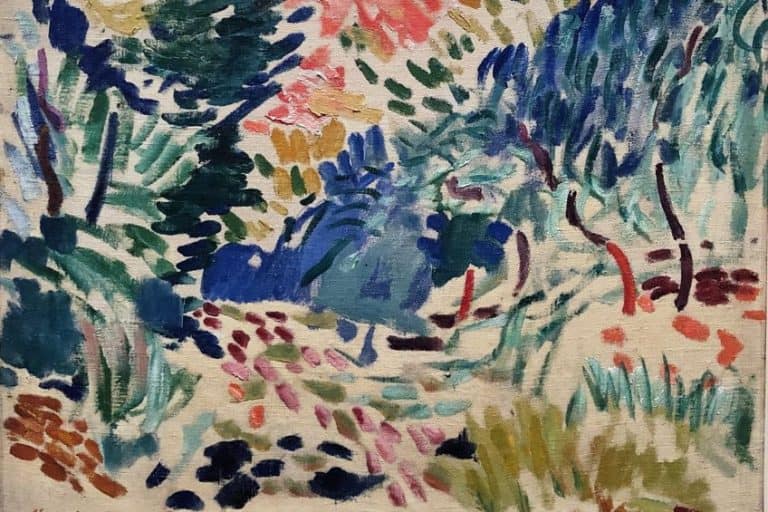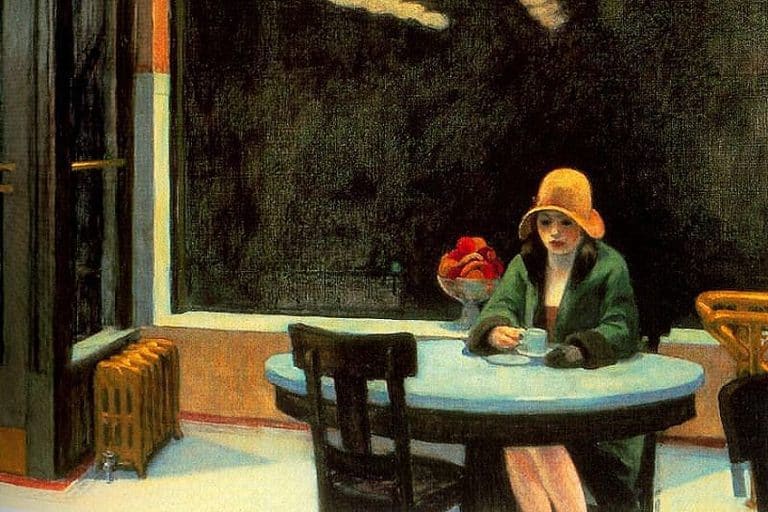Judith and Holofernes by Gustav Klimt – Decoding This Masterpiece
Gustav Klimt’s “Judith and Holofernes” from 1901 offers a striking reinterpretation of the biblical tale where a Jewish widow beheads an Assyrian general to save her city. Klimt transforms the traditional narrative into a complex exploration of female sexuality, power, and violence through his distinctive gold-laden Art Nouveau style. The painting features Judith with a seductive expression and partially exposed breasts, holding Holofernes’ severed head, challenging viewers to reconsider the relationship between desire and death in this ancient story.
Key Takeaways
- Klimt’s “Judith and Holofernes” merges biblical narrative with modern sexual psychology through its provocative portrayal of the heroine.
- The artwork represents a pivotal moment in Klimt’s artistic development during his “Golden Phase” of Viennese Secession movement.
- The painting continues to provoke discussion about female agency, sensuality, and violence in art history.
| Artist | Gustav Klimt (1862 – 1918) |
| Date Painted | 1901 |
| Medium | Oil on canvas |
| Genre | Symbolism / Biblical |
| Period / Movement | Vienna Secession |
| Dimensions (cm) | 84 x 42 |
| Series / Versions | Part of Klimt’s “Judith” series (Judith I and Judith II) |
| Where Is It Housed? | Österreichische Galerie Belvedere, Vienna |
| What It Is Worth | Considered priceless; not for sale |
Judith and Holofernes Analysis
Klimt’s portrayal of the biblical tale of Judith and Holofernes represents a striking departure from traditional depictions, emphasizing female sensuality and power. The painting merges biblical narrative with modern psychological interpretation, creating a work that challenges viewers to reconsider the familiar story.
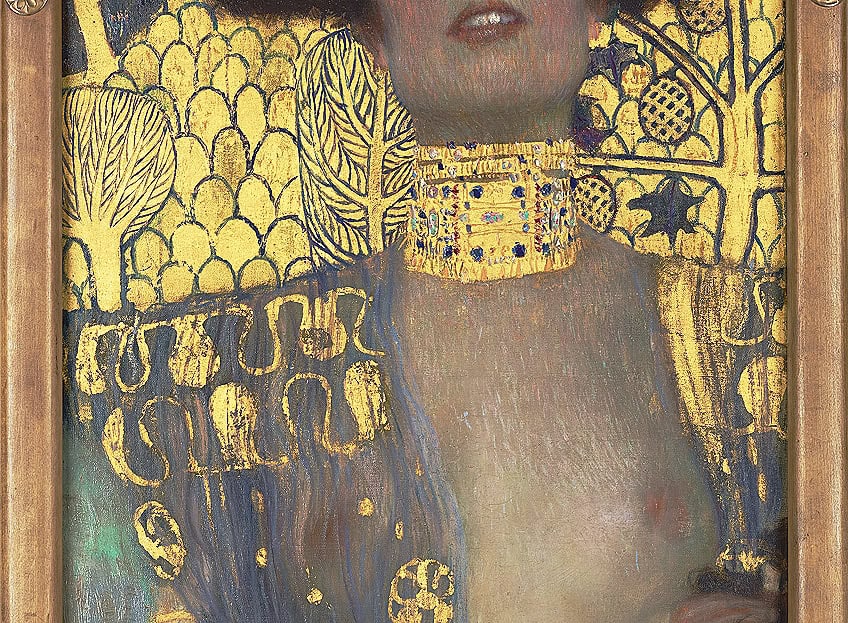
Technical Aspects
Completed in 1901, Klimt executed “Judith and Holofernes” using oil on canvas with gold leaf applications, a technique that became his signature style. The painting measures 84 × 42 cm and demonstrates Klimt’s mastery of the Viennese Secession aesthetic.
The artist employs a rich palette dominated by golds and deep greens, creating luxurious contrast against Judith’s pale skin. His brushwork varies throughout the piece—precise and detailed in Judith’s face and jewelry, yet more expressive in the handling of the background and decorative elements.
Klimt’s technical innovation appears in the textural variations. The gold leaf application creates reflective surfaces that change with viewing angle and lighting conditions, adding a dynamic quality to the static image.
Iconography and Symbolism
Klimt departs significantly from traditional iconography in his interpretation of Judith. While the biblical Judith is typically portrayed as a pious heroine who acts for her people, Klimt’s Judith exudes sensuality and personal pleasure in her triumph.
The severed head of Holofernes appears partially cropped at the bottom edge, diminishing the general’s importance and emphasizing Judith’s dominance. This compositional choice shifts focus from the act of heroism to Judith’s psychological state.
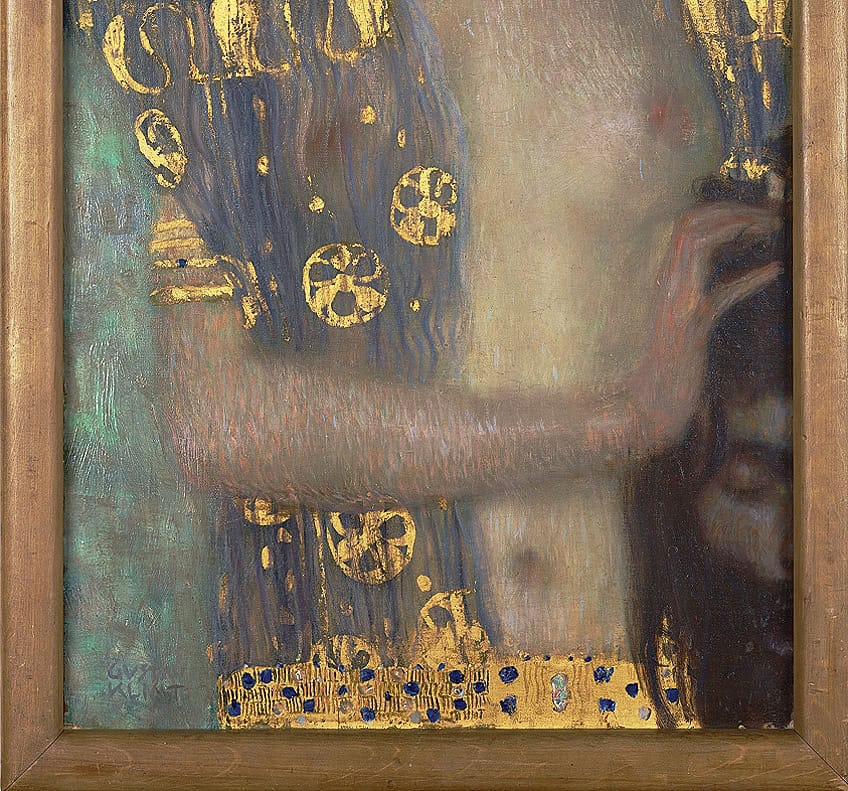
The gold background and ornate jewelry reference Byzantine art while symbolizing luxury and power. Judith’s half-closed eyes and parted lips suggest both ecstasy and power, blurring the line between religious virtue and erotic fulfillment.
The painting’s ambiguous symbolism has led some critics to interpret it as an exploration of feminine power and male anxiety in fin-de-siècle Vienna.
Compositional Analysis
The vertical composition emphasizes Judith’s elongated neck and elegant posture, creating a sense of regal authority. Klimt places Judith centrally against a decorative background, isolating her figure and intensifying her presence.
Strong vertical and diagonal lines guide the viewer’s eye from Holofernes’ severed head upward to Judith’s face—the emotional center of the composition. This arrangement reinforces the power dynamic between victor and vanquished.
Klimt utilizes negative space strategically around Judith’s figure to create a sense of isolation and focus. The decorative patterns in the background create visual complexity while remaining subordinate to the figure.
The artist’s strategic use of light draws attention to Judith’s face and décolletage, highlighting her sensuality while the rest of the composition recedes into decorative patterns and darker tones.
Cultural and Social Significance
Klimt’s depiction of Judith has sparked extensive cultural discourse, challenging traditional interpretations of feminine power while confronting viewers with uncomfortable juxtapositions of sexuality and violence. The painting exists at the intersection of religious narrative and turn-of-the-century Viennese anxieties.
Feminine Power and Virtue
Klimt’s “Judith” subverts traditional portrayals of the biblical heroine by emphasizing her sexuality rather than her virtuous nature. Unlike earlier Renaissance and Baroque depictions where Judith appears modest and reluctant, Klimt presents her as confident and even pleased with her violent deed.
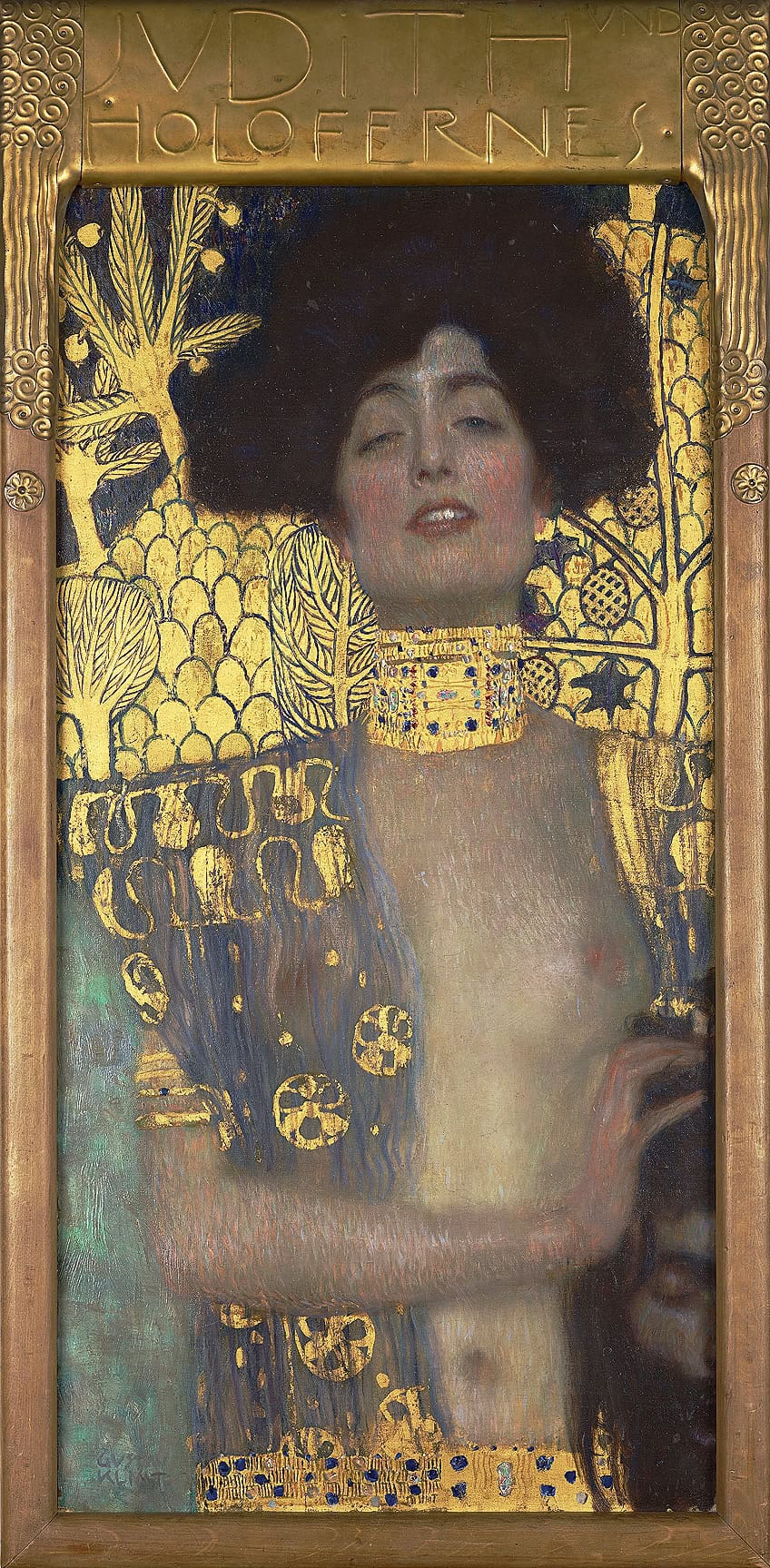
The painting emerged during Vienna’s fin-de-siècle period when societal attitudes toward women were shifting. Judith embodies the “femme fatale” archetype, representing both attraction and danger to the male viewer.
Her half-closed eyes and parted lips suggest both sensuality and power, challenging patriarchal norms of the time. This representation reflects contemporary anxieties about women’s changing social roles and emerging independence.
Judith as a Symbol of Courage
Despite controversial elements, Klimt’s work preserves Judith’s fundamental role as God’s instrument of salvation for her people. The biblical narrative positions her as a courageous woman who sacrifices her safety to save her city from the Assyrian general Holofernes.
Her willingness to enter the enemy camp alone demonstrates extraordinary bravery. The violent beheading, though shocking, represents the necessary action to protect her community from destruction.
In Jewish tradition, Judith exemplifies resourcefulness and faith. Her story was particularly resonant in early 20th century Europe as Jewish communities faced increasing antisemitism, with Judith representing resistance against oppression.
Modern Interpretations and Critiques
Contemporary viewers often focus on Klimt’s blending of eroticism and violence, seeing the work as commentary on gender politics rather than religious narrative. Feminist art historians have both celebrated and criticized the painting—acknowledging its bold portrayal of female agency while questioning its male-gaze orientation.
Some critics argue Klimt transforms Judith from heroic liberator to sexual predator, reflecting turn-of-the-century fears about female sexuality. Others suggest the painting critiques antisemitic stereotypes prevalent in Vienna at the time.

Recent artistic responses, like Kehinde Wiley’s 2012 reinterpretation, transform Judith into a symbol against white supremacy. This demonstrates how Klimt’s revolutionary approach to the subject continues to inspire contemporary artists to explore power dynamics and social justice through the Judith narrative.
Artistic Context
Gustav Klimt painted “Judith and the Head of Holofernes” in 1901, during Vienna’s vibrant fin-de-siècle cultural period. This work stands as a notable departure from traditional religious interpretations of the biblical heroine.
Unlike earlier Renaissance and Baroque depictions by artists like Caravaggio and Artemisia Gentileschi, Klimt transformed Judith from a virtuous heroine into a sensual femme fatale. This interpretation aligned with the period’s fascination with dangerous female sexuality.
The femme fatale concept was particularly popular among Symbolist artists of the era. Franz Stuck similarly explored themes of female power and sexuality in his works, contributing to the period’s reinterpretation of biblical and mythological women.
Klimt’s painting shares thematic elements with contemporary depictions of Salome, another biblical figure who obtained a man’s head and was frequently portrayed with erotic undertones. Both characters represented the period’s complex attitudes toward female power.
The gold elements in the painting reflect Klimt’s “Golden Phase” and his interest in Byzantine mosaics. This stylistic choice emphasizes Judith’s elevated, almost icon-like status while maintaining her sensuality.
Klimt’s approach sparked controversy and fascination, challenging viewers to reconsider traditional narratives. His Judith embodied contemporary Viennese anxieties about female sexuality and power rather than simply retelling a biblical story.
Preservation and Display
Gustav Klimt’s “Judith and Holofernes,” completed in 1901, currently resides in the Belvedere Museum in Vienna, Austria. The painting is mounted on a robust stretcher bar made of sustainable wood, ensuring structural integrity while aligning with modern conservation practices.
Museum conservators monitor the painting’s condition regularly, paying particular attention to the gold leaf applications characteristic of Klimt’s golden period. The artwork is protected by specialized acrylic glass that filters harmful UV rays while providing optimal visibility.
The display arrangement employs orthogonal projection principles, allowing viewers to appreciate the work from multiple angles without distortion. Carefully positioned hanging lamps create balanced illumination that enhances the painting’s color brilliance without causing light damage.
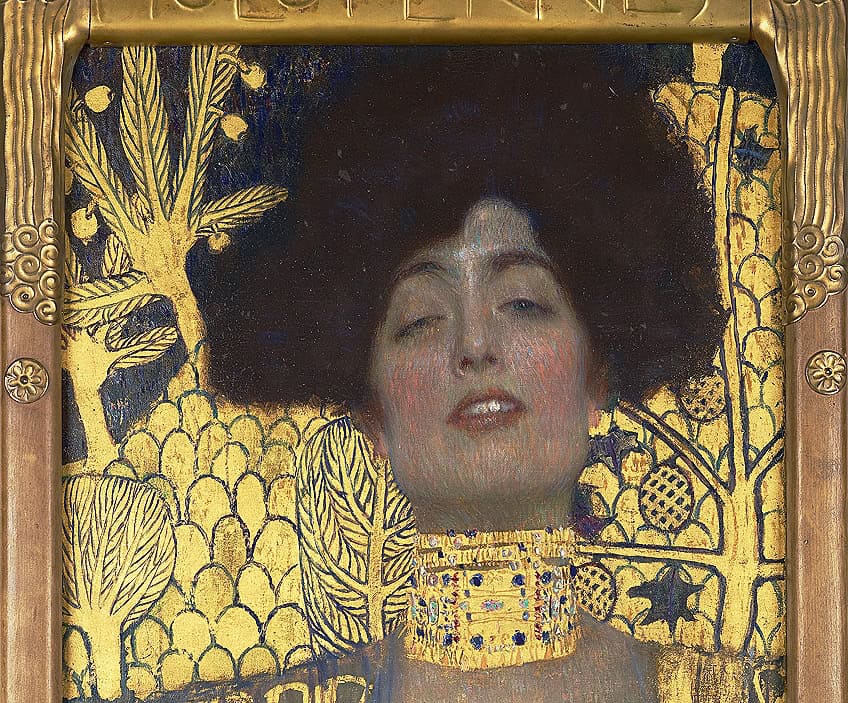
Temperature and humidity levels are strictly controlled to prevent deterioration of the canvas and paint layers. This careful environmental management helps preserve the vivid colors and intricate details that make this portrayal of Judith so compelling.
The painting shares exhibition space with other Klimt masterpieces, including the famous portrait of Adele Bloch-Bauer. This contextual display helps visitors understand Klimt’s artistic evolution during his golden period and his recurring interest in powerful female subjects.
Digital scanning and documentation have created detailed records of the painting’s current condition, supporting long-term preservation efforts and allowing for virtual access to this important artwork.
Frequently Asked Questions
Gustav Klimt’s “Judith and the Head of Holofernes” raises several important questions regarding symbolism, interpretation, and artistic influences.
What symbols does Klimt employ in ‘Judith and the Head of Holofernes’ to convey meaning?
Klimt utilizes gold tones and ornate patterns to symbolize wealth, power, and the Byzantine artistic tradition. Judith’s facial expression and half-closed eyes convey both sensuality and triumph, creating a complex symbolic portrayal of feminine strength.
How does Klimt’s interpretation of ‘Judith and Holofernes’ differ from traditional Biblical depictions?
Klimt portrays Judith as a sensual femme fatale rather than a virtuous widow, emphasizing her sexuality and pleasure instead of her pious heroism. Unlike traditional depictions focusing on the violent beheading, Klimt’s version presents an after-scene with minimal gore, highlighting instead the psychological aspects of power and desire.
What are the artistic influences reflected in Klimt’s ‘Judith and Holofernes’?
The painting demonstrates Klimt’s signature Viennese Secession style with its decorative gold elements and flattened perspective. Art Nouveau influences appear in the flowing lines and stylized forms, while the work also reflects fin-de-siècle Vienna’s fascination with female sexuality and psychological complexity.
Isabella studied at the University of Cape Town in South Africa and graduated with a Bachelor of Arts majoring in English Literature & Language and Psychology. Throughout her undergraduate years, she took Art History as an additional subject and absolutely loved it. Building on from her art history knowledge that began in high school, art has always been a particular area of fascination for her. From learning about artworks previously unknown to her, or sharpening her existing understanding of specific works, the ability to continue learning within this interesting sphere excites her greatly.
Her focal points of interest in art history encompass profiling specific artists and art movements, as it is these areas where she is able to really dig deep into the rich narrative of the art world. Additionally, she particularly enjoys exploring the different artistic styles of the 20th century, as well as the important impact that female artists have had on the development of art history.
Learn more about Isabella Meyer and the Art in Context Team.
Cite this Article
Isabella, Meyer, “Judith and Holofernes by Gustav Klimt – Decoding This Masterpiece.” Art in Context. May 4, 2025. URL: https://artincontext.org/judith-and-holofernes-by-gustav-klimt/
Meyer, I. (2025, 4 May). Judith and Holofernes by Gustav Klimt – Decoding This Masterpiece. Art in Context. https://artincontext.org/judith-and-holofernes-by-gustav-klimt/
Meyer, Isabella. “Judith and Holofernes by Gustav Klimt – Decoding This Masterpiece.” Art in Context, May 4, 2025. https://artincontext.org/judith-and-holofernes-by-gustav-klimt/.






